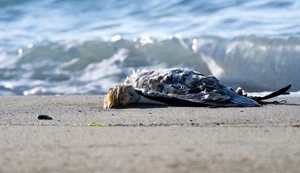Highly Pathogenic Avian Influenza (HPAI) and our wild birds
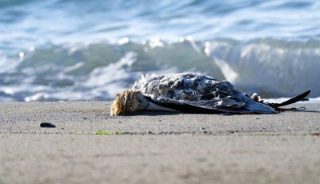
In September, an event occurred which is likely to change the number and variety of birds that we know on the Roseland.
Carne, Pendower, Porthbean, Towan and Porthbeor became edged at the tideline with the corpses of Gannets, their blue eyes turned to glazed grey. And from the skies others tumbled onto the Roseland’s clifftop fields to die. Bird flu had hit us.
Although it has occurred for many years, this is by far the worst so far. It is especially worrying for poultry farmers and our hearts go out to them as they cope with the restrictions and threats of culling their stock in these awful times.
Bird flu is a type of influenza, which can be highly pathogenic amongst birds, attacks their respiratory and digestive tracts, causing internal bleeding, and is spread by contact and through their faeces. This explains why it occurs chiefly, but not solely, in close-knit bird colonies which are often on offshore islands around our coastline. Previously it has been considered to be seasonal, associated with the autumn influx of migratory geese and wildfowl, but this year outbreaks have been recorded in every month.
Analysing corpses in the UK this year DEFRA has confirmed bird flu not just in the enormous numbers of deceased Gannets, but in other birds too. It started incredibly early in the year in Scotland on both north east and northwest coastal areas and islands such as Orkney and Shetland. Some areas had isolated cases, but others had whole colonies decimated, at St Kilda for example, where around 100 Great Skua perished, practically the whole of the UK population. On Bass Rock in the Firth of Forth, the biggest colony of Northern Gannets in the world, normally holding 150000 birds, is estimated to have lost at least 50% of the breeding birds, which incidentally pair for life. And then, in England, in Northumberland, the rare Roseate Tern colony on Coquet Island and the Sandwich Tern colony were practically wiped out; while on the Farne Islands Puffins, Guillemots, Razorbills, Arctic Terns and Common Terns were hit very badly. In Norfolk, on the Broads, waterfowl such as swans, geese and ducks were affected, and coastal tern and gull colonies seriously hit.
There are no Gannet colonies in Cornwall, yet they are usually observed daily in any seawatch, sometimes in considerable numbers. So where are they likely to be from?
Our nearest colonies are in Wales where several thousand Gannets perished on Grassholm Island, the third largest Northern Gannet colony in the world, around 150 miles away from us. Off Alderney, at Les-Etecs,125 miles away, where over a thousand birds have died; and at Sept-Iles,140 miles away in northern Brittany, where the largest colony in France has been appallingly hit. An adult Gannet can fly at 30-40 mph and its fishing range, as we know from GPS tagged birds, can be in the region of 500 miles in a single round trip from its colony!
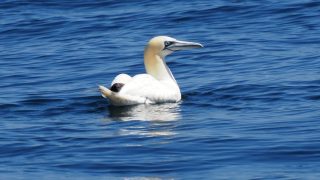
Other species being severely affected are Fulmar, Kittiwake, Common Tern, Herring Gull, Greater Blackbacked, Lesser Blackbacked and Black-headed Gull. Eider, Greylag, Pink-footed and Canada Geese, Whooper Swan, Mute Swan, Great Skua and Cormorant have also suffered large losses.
Additionally, there has been enormous losses in fledglings hatched, as the adults have perished and so the chicks have either starved, been predated or perished with bird flu themselves.
Uncollected infected carcasses are now being eaten by birds of prey with disastrous effects. DEFRA’S 2022 bird flu list of UK deaths so far includes Golden Eagle, White-tailed Sea Eagle, Peregrine Falcon, Common Buzzard, Kestrel, Hen Harrier, Red Kite, and Sparrowhawk.
Look online to see the devastation the virus is causing in all the continents of the world, affecting colonies, for example, from Cranes and Pelicans in Israel to Penguins in South Africa and Vultures in North America.
It may not have seriously hit garden birds yet, although House Sparrow, Starling and Woodpigeon numbers appear to be low. However, just a few words of advice which might be helpful. Either keep your bird feeders clean or do not use them. Keep your dogs on leads on beaches, as there have been exceedingly rare cases of fatal transmission to animals, such as Red Fox.
Report dead wild waterfowl (swans, geese, or ducks) and other dead wild birds, such as gulls or birds of prey to Defra’s GB helpline: 0349 335577.
Sorry for the depressing nature of this article, but I thought you ought to be aware that it has not gone away.Some fear the worst is yet to come. Let’s hope that they are wrong, and that Nature can recover.
For there is some good news! As I write this in late October our shores are no longer littered with the corpses of affected birds. Guillemots are increasing daily as they fly past in lines, purposefully and quickly, heading low into the wind. Finally, frequent sightings are coming in from fishing boats and observers on the shore of small parties of Gannets, both adults, sub-adults and juveniles, successfully feeding again in the bay from Kiberick to the Lizard and beyond!
David Hall
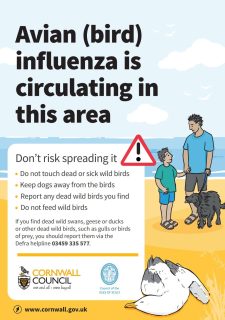
Wild Roseland’s next event
Why ring Birds?
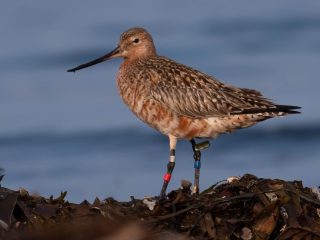
All welcome. Admission by donation.
An evening with Mark Grantham, Chair of CBWPS
The importance of Bird Ringing and Tracking, its history and the latest developments, the practical work of the West Cornwall Ringing Group and how anyone could become involved in ringing here on the Roseland.

